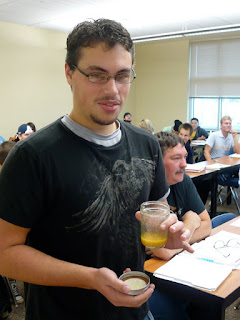It’s illegal. It’s illegal, as it turns out, to pump your own gas in Oregon --
which you learn when a very sweet young guy in a reflective vest is standing next to your window as you are looking for your credit card. Car stuffed to the brim, you have just gone on a mad dash through a huge discount store called WinCo to get food to teach the next day's healthy cooking classes -- lots of very cheap vinegars and oils and 62 cent packets of spice. At the end of a long driving day, you are literally running to and from the register, remembering the importance of social interaction with strangers, that nice, nice woman who held your place in line while you legged it to the far back corner of a cavernous store where raisins are kept in full-size barrels.
Although Portland is a literary capital of the country, it is also in the window of cities that fell through the cracks between the first publicist leaving the project and my own ability to reboot and plan things. I talk to at least three very nice, independent bookstore owners who all said they would have liked to have done something, but the timing was just too tight. (On the plus side, these conversations generated the idea of Museum Legs, the Halloween costume, which would debut in Seattle.)
Portland is most known for the bookstore Powell's, which I visited twice, once to their neighborhood location as a shopper, and once to their downtown mecca, to visit Museum Legs on the shelf (where it was well concealed from buyers in the museology section).
So, instead of doing a reading, I was teaching three healthy cooking classes, as a guest of Carrie Bader, sister of my friend Christine. The rationale was that cooking as an everyday art form most people have access to.
So, I showed slides about what a visual age we live in, how we even had machines that are visual thinkers (UPC and zip-code readers). I talked about creative and imaginative "breakthrough" moments, and then focused on composition and color. The plate is the blank canvas in cooking, and we looked at artworks to think about arrangement of objects on a plate.
Then we looked at a color wheel and divided into groups to think of as many foods as possible that were different colors -- a reds/purples group, an oranges/yellows group, and a green group. (It says something good, I think, that people went through most natural foods before getting to green marshmallows or even butter.)
As a segueway, I talked about how intimidating some parts of the green list are. Learning to cook kale was, for me, as intimidating as crossing the threshold of a modern art museum for the first time.
Carrie and I polled each class to ask how many people bought bottled salad dressing. In every class, all but one person raised a hand. So, I talked about how sauces are one way to make those green veg less intimidating, and then taught them how to make vinaigrette.
There was a nice 'Price is Right' interlude in which I would explain how cheap the ingredients were ($1.72 for vinegar, 88 cents for apple cider vinegar) to prove that this could also be a budget-conscious move. I happened to have watched the 'Price is Right' religiously when I was ten, and rather enjoyed this.
I may not have changed anyone's relationship to art, but I think they all now know how to make a vinaigrette. They might also think more about the colors of their food.










No comments:
Post a Comment